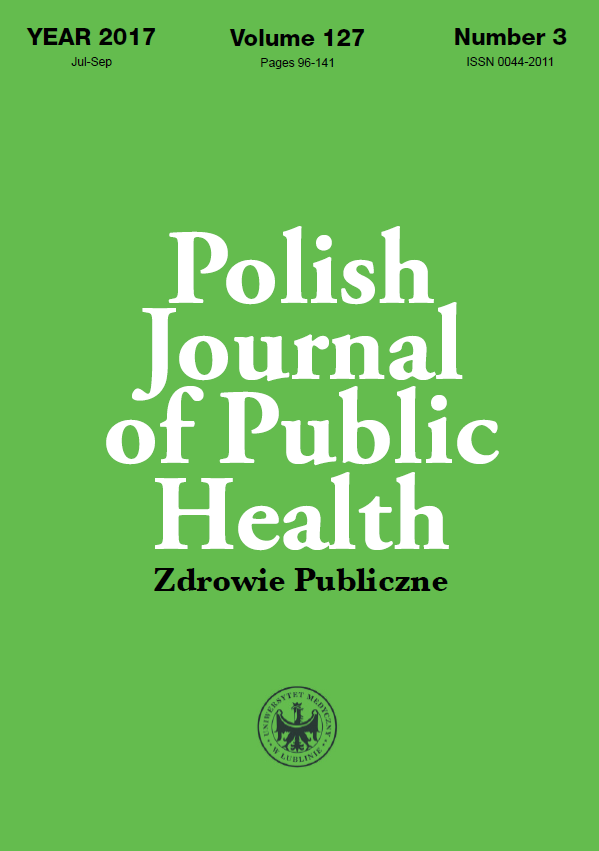Public awareness about the use of automatic external defibrillator (AED) in giving first aid
DOI:
https://doi.org/10.1515/pjph-2017-0022Keywords:
automated external defibrillator (AED), cardiopulmonary resuscitation, social awareness, first aidAbstract
Introduction. Chances for survival of a patient who has suffered from sudden cardiac arrest (SCA) depend on a number of factors. One of the most important however, is the time within which the patient is provided with actions to restore normal heart function. In the Guidelines for Resuscitation 2015, The European Resuscitation Council states that defibrillation done within 3-5 minutes since a patient with SCA lost his/her consciousness can increase the survival rate up to 50-70%. However, such a short time of providing help is only achievable through the implementation of universal defibrillation programs and the automatic external defibrillator (AED) devices densely distributed in public places. By contrast, every minute of delay in defibrillation reduces the probability of survival by approximately 10-12% until the hospital discharge.
Aim. The purpose of the research was to elicit the opinions of adult respondents on first aid and the use of automatic external defibrillator (AED).
Material and methods. The research method used in this paper was a diagnostic survey, the technique was a web-based questionnaire, and a research tool was the authors’ own questionnaire survey. The survey was active between April 8, 2016 and May 20, 2016. During this time, 116 opinions were collected.
Results. As many as 77% of respondents declared that they had attended a first aid course, but 21% of them stated that they no longer remembered the knowledge acquired. The number of 63% of respondents did not know what an automatic external defibrillator is. Only 27% of respondents knew that AEDs are public devices, and only 47% believed that using an AED would not worsen the health of the victim.
Conclusions. The availability of AEDs and knowledge of their use are insufficient. Low social awareness and irrational fear of using an AED (fear of deterioration of the victim’s health) support the need for continuing education in this area.
References
1. Europejski Raport Zdrowia 2012, Droga do osiągnięcia dobrostanu. WHO; 2012.
2. Ustawa z dn. 8 września 2006 r. o Państwowym Ratownictwie Medycznym.
3. Szczeklik A. (ed). Choroby wewnętrzne. Kraków: Medycyna Praktyczna; 2005.
4. Wieczorski M, Stodółkiewicz E. Aktualne rozwiązania w zakresie defibrylacji i kardiowersji. Acta Bio-Optica et Informatica Medica. 2009;3(15):253, 256.
5. Wytyczne resuscytacji ERC 2015. [http://www.prc.krakow.pl/wyt2015/2_BLS.pdf6.
6. Encyklopedia PWN. [http://encyklopedia.pwn.pl/haslo/depolaryzacja;3891867.html]
7. Trybus-Gałuszka H, Sokołowska-Kozub T. Defibrylacja. [http://www.prc.krakow.pl/wyd/2006/skrypt_2006-AED.pdf]
8. Skonieczny G., Marciniak M, Jaworska K. Nagłe zatrzymanie krążenia – możliwości zastosowania defibrylacji w prewencji pierwotnej i wtórnej. Forum Med Rodz. 2012;6(6):283-90.
9. Staniszewska A, Korczak A, Juszczyk G, et al. Wiedza kursantów ośrodków szkolenia kierowców odnośnie użycia automatycznego defibrylatora zewnętrznego (AED) w trakcie akcji ratunkowej. J Edu Health Sport. 2015;5(5):67.
10. Surowiec A, Wołowiec Ł, Plaskiewicz A, et al. Postępowanie diagnostyczno-terapeutyczne u pacjenta po nagłym zatrzymaniu krążenia w mechanizmie migotania komór – opis przypadku. J Health Sci. 2013;3: 408.
11. Mocha J, Wójcik D, Sobotnicki A. Problematyka zabezpieczenia aparatury elektromedycznej przed skutkami defibrylacji. Prz Elektrotech. 2014;7:210.
12. Leszczyński P. Metody nauczania resuscytacji. J Publ Health Nurs Med Rescue. 2012;4:50-55.
13. Salska A, Chiżyński K, Salski W, et al. Rzadkie choroby układu krążenia w kontekście opieki profilaktycznej nad pracownikiem. Med Pr. 2014;6:848.
14. Węgielnik J, Basiński A. Resuscytacja krążeniowo-oddechowa u dorosłych. Postępowanie w zadławieniu. Forum Med Rodz. 2008;3(2):187-96.
15. Perkins GD, Handley AJ, Koster RW, et al. Podstawowe zabiegi resuscytacyjne u osób dorosłych oraz zastosowanie automatycznych defibrylatorów zewnętrznych (AED). Wytyczne ERC 2010. p. 90. [ www.prc.krakow.pl/2010/]
16. International Liaison Committee on Resuscitation. [www.ilcor.org].
17. Kotarski R. AED – maszyna, która ratuje życie. [http://polimaty.pl/2013/12/aed-maszyna-ktora-ratuje-zycie]
18. [http://www.ratujzsercem.pl]
19. Olejniczak D, Miciuk D, Religioni U. Ocena stanu wiedzy studentów Warszawskiego Uniwersytetu Medycznego na kierunku pielęgniarstwo na temat udzielania pierwszej pomocy przedmedycznej. Piel Zdr Publ. 2013;3:103-4.
20. Chemperek E, Goniewicz M, Włoszczak-Szubzda, et al. Poziom wiedzy uczniów szkół ponadgimnazjalnych i studentów w zakresie pierwszej pomocy. MONZ. 2011;4(17):176.
21. Musiał P, Makowski K, Adamczyk-Krupska D, et al. Ocena poziomu wiedzy osób dorosłych na temat resuscytacji krążeniowo-oddechowej i użycia automatycznego defibrylatora zewnętrznego w miejscach publicznych. J Publ Health Nurs Med Rescue. 2015;4:44-6.
22. Strzyżewska K, Mędrzycka-Dąbrowska W, Dąbrowski S, Basiński A. Ocena poziomu wiedzy studentów aglomeracji trójmiejskiej z zakresu udzielania pierwszej pomocy. Anest Ratow. 2012;6:42.
23. Wojczyk A. Stan wiedzy studentów pielęgniarstwa na temat resuscytacji krążeniowo-oddechowej. Puls Uczelni. 2015;9:7, 11.
24. Fredman D, Haas J, Ban Y, et al. Use of a geographic information system to identify differences in automated external defibrillator installation in urban areas with similar incidence of public out-of-hospital cardiac arrest: a retrospective registry-based study. BMJ Open. 2017;7(5):e014801.
25. Deakin CD, Shewry E, Gray HH. Public access defibrillation remains out of reach for most victims of out-of-hospital sudden cardiac arrest, Heart 2014; 100 (8): 619-23.
26. Salciccioli JD, Marshall DC, Sykes M, et al. Basic life support education in secondary schools: a cross-sectional survey in London, UK BMJ Open 2017; 7: e011436.
27. Cacko A, Wyzgał A, Galas A, et al. Dostępność automatycznych zewnętrznych defibrylatorów na terenie miasta Warszawy – stan na maj 2009 roku. Kardiol Pol. 2010;68:46.
Downloads
Published
Issue
Section
License
Copyright (c) 2018 Polish Journal of Public Health

This work is licensed under a Creative Commons Attribution-NonCommercial-NoDerivatives 3.0 Unported License.


